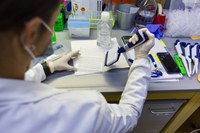Single-Cell RNA Sequencing Analysis: A Step-by-Step Overview
Authors: Slovin S., Carissimo A., Panariello F., Grimaldi A., Bouché V., Gambardella G.
Year: 2021
Sources: RNA Bioinformatics. Methods in Molecular Biology, vol 2284. Humana, New York, NY.
Abstract:
Thanks to innovative sample-preparation and sequencing technologies, gene expression in individual cells can now be measured for thousands of cells in a single experiment. Since its introduction, single-cell RNA sequencing (scRNA-seq) approaches have revolutionized the genomics field as they created unprecedented opportunities for resolving cell heterogeneity by exploring gene expression profiles at a single-cell resolution. However, the rapidly evolving field of scRNA-seq invoked the emergence of various analytics approaches aimed to maximize the full potential of this novel strategy. Unlike population-based RNA sequencing approaches, scRNA seq necessitates comprehensive computational tools to address high data complexity and keep up with the emerging single-cell associated challenges. Despite the vast number of analytical methods, a universal standardization is lacking. While this reflects the fields’ immaturity, it may also encumber a newcomer to blend in.
In this review, we aim to bridge over the abovementioned hurdle and propose four ready-to-use pipelines for scRNA-seq analysis easily accessible by a newcomer, that could fit various biological data types. Here we provide an overview of the currently available single-cell technologies for cell isolation and library preparation and a step by step guide that covers the entire canonical analytic workflow to analyse scRNA-seq data including read mapping, quality controls, gene expression quantification, normalization, feature selection, dimensionality reduction, and cell clustering useful for trajectory inference and differential expression. Such workflow guidelines will escort novices as well as expert users in the analysis of complex scRNA-seq datasets, thus further expanding the research potential of single-cell approaches in basic science, and envisaging its future implementation as best practice in the field.
In this review, we aim to bridge over the abovementioned hurdle and propose four ready-to-use pipelines for scRNA-seq analysis easily accessible by a newcomer, that could fit various biological data types. Here we provide an overview of the currently available single-cell technologies for cell isolation and library preparation and a step by step guide that covers the entire canonical analytic workflow to analyse scRNA-seq data including read mapping, quality controls, gene expression quantification, normalization, feature selection, dimensionality reduction, and cell clustering useful for trajectory inference and differential expression. Such workflow guidelines will escort novices as well as expert users in the analysis of complex scRNA-seq datasets, thus further expanding the research potential of single-cell approaches in basic science, and envisaging its future implementation as best practice in the field.
Category: books

